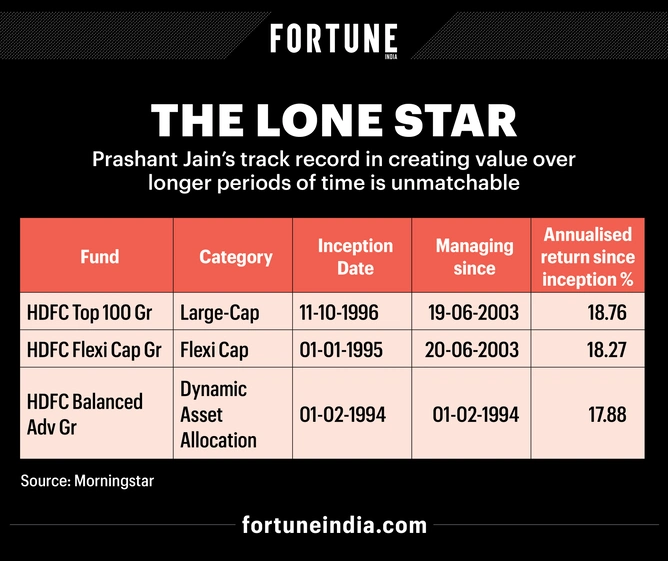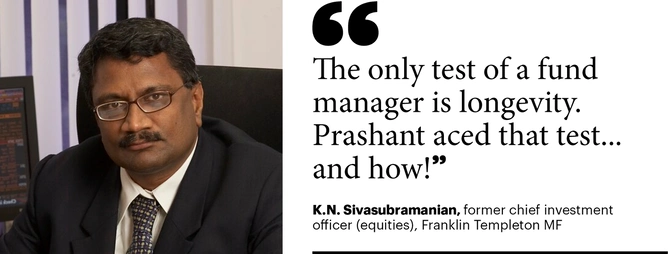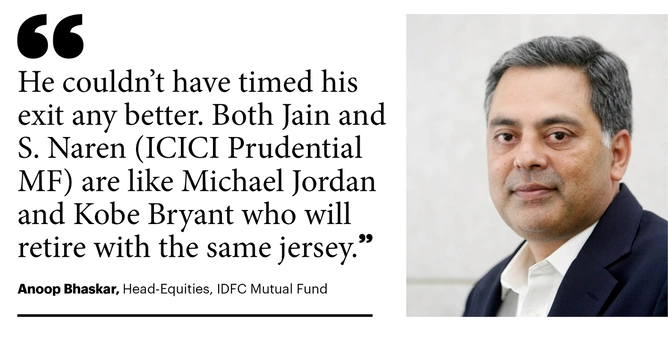It’s ironic that HDFC Mutual Fund’s longest-serving chief investment officer, Prashant Jain, called it quits (on July 22), just days after the country’s third-largest fund house sent out a press release on July 18, celebrating the 20th anniversary of its index funds. The release went on to state that the AMC has been a “pioneer” in the space. “This is a testament to the vision of HDFC AMC’s leadership, who understood the benefits of index solutions and created an innovative product for Indian investors,” read the release.
What’s also unmissable is how matter of fact the construct of the AMC’s notice to the exchange was, as it read: “...Mr. Prashant Jain, chief investment officer of the company, after 19 years, has decided to move on and has tendered his resignation...” In contrast, the tone was more effusive about Chirag Setalvad and Shobhit Mehrotra, who were appointed as heads of equities and fixed income, respectively. “Both Mr. Setalvad and Mr. Mehrotra are capable investment professionals, ready to take up the mantle of heading the equities and fixed income function and are well supported by a highly experienced and committed team of investment professionals,” read the notice.
But then the soft-spoken IIT-ian from Kanpur would care less about such niceties as right through his 31-year-long career he has been more focussed about doing what he did best — stick to his style of investing even when the tide went against him. Compared with assets under its index funds, HDFC’s assets under actively managed equity funds was ₹1.97 lakh crore as of June 30, 2022. In fact, of the five largest equity funds that account for over 71% of the total equity assets, Jain manages three funds — HDFC Top 100, HDFC Flexi Cap and HDFC Balanced Advantage. The largest fund is HDFC Balanced Advantage, with a corpus of ₹43,079 crore, which has delivered annualised return of 17.88% since its inception in 1994 from a corpus of ₹35.5 crore. Meanwhile, HDFC Top 100 (₹19,910 crore) has delivered an annualised return of 18.76% since its inception in 1996 (Jain took over in 2003). HDFC Flexi Cap (₹26,511 crore) has delivered 18.27% since inception, and 20.74% return from 2003, when Jain began managing the fund.

Jignesh Desai, co-founder of NJ Invest, the country’s biggest mutual fund distributor, believes Jain’s legacy is unbeatable. “He is an amazing guy with his own thoughts. He had the ability to convince investors about his investing rationale,” says Desai, whose firm caters to 1 million customers from 16,000 pin codes across the country.
That the size of the fund had become too big to handle for Jain’s successors is evident given that, for the first time in its 28-year history, HDFC Balanced Advantage will be run by three managers – while Srinivasan Ramamurthy will be responsible for asset allocation, Gopal Agrawal and Anil Bamboli will be the co-fund managers. “Overall, HDFC as a group is process-oriented and I am sure they have taken care about creating a strong second line of successors,” feels Desai.
In fact, the annualised return of the Advantage Fund, which Jain had managed since inception (February 1994), outshines that of the Sensex, which delivered around 10% annualised return. Not surprising that Jain is the country's only fund manager to have had the distinction of cumulatively managing assets of ₹1 lakh crore.
A feat that his peers acknowledge — K.N. Sivasubramanian is one of them.
One of the most successful and best regarded equity fund managers, Sivasubramanian, who is elder to Jain, had stepped down in 2014 as the chief investment officer (equities) at Franklin Templeton MF, after a stint of 20 years. “It’s the end of a pathbreaking era in the fund management industry. In a business known for flamboyance and verbosity, he was a true contrarian... down to earth and humble! There have been many “shooting stars” over the years but only one constant, the Polestar. The only test of a fund manager is longevity (returns and everything else is subsumed in that). Prashant aced that test... and how!” Sivasubramanian tells Fortune India.

Both the stalwarts had begun their careers around the same time. Sivasubramanian started off as a portfolio manager in 1994 with Kothari Pioneer, which was later acquired by Franklin Templeton. Jain started off with SBI Mutual Fund in 1993 before moving to Zurich Asset Management, which was acquired by HDFC Mutual Fund in 2003.
While value investing in a growing economy like India is an oxymoron, Jain was a value seeker in growth stocks by following a keep-it-simple approach to bottom-up investing. His formula was three-pronged: focus on sustainability of businesses, managements of a certain quality with a clear preference for growth, and value. His belief is that over longer periods, the entry point of an investment made a substantial impact on return. Hence, for Jain, value is extremely important. But that comes at a cost, when Mr. Market favours growth over value, resulting in periodic underperformance. But Jain is steadfast in his approach. “If you have to choose between investment performance vs investing principles, I firmly believe that, over time, if your principles are sound, they will lead to good performance,” Jain had told Fortune India in an earlier interaction.
Jain has been a big votary of public sector undertakings (PSUs) right through his career. For instance, the BAF’s (Balanced Advantage Fund) single-biggest weightage is in State Bank of India at 7.11%, followed by Coal India at 4.37% and NTPC 3.91%. Anoop Bhaskar, head-equities, IDFC Mutual Fund, says, “He was the very first to identify the banking sector as a proxy for economic growth and went overweight on banks in his portfolio. As the banking sector weightages moved up in the indices, he got a huge advantage despite not owning HDFC Bank. Also, how many people would be holding Coal India for so long especially amid the onslaught of ESG investing?” says Bhaskar.

While PSUs are his favourite, consumer stocks are pariahs, given their expensive multiples. Jain believes that though these companies have good free cash flows, multiples do not justify their growth. In fact, he was the earliest to have sold off Page Industries, after which the prices continued to still head north. “If you look at the past 10 years, in many cases, consumer companies’ top line growth was in high single digits, but the multiples they trade at are anywhere between 50x and 100x. The reason for that probably lies in the margin expansion which was partly on account of the GST cuts which, probably, were not passed on to consumers,” Jain told Fortune India.
But the steadfast devotion to valuation also meant Jain’s funds had to endure long periods of underperformance and the recent one being the longest — seven years long between 2013 and 2020. But he never let the pressure get to him. “I’m a veteran at periodically underperforming... and I have come out of it. If you try to jump from one style to another, in the long term the outcome is very likely to be very mediocre. My best chances for delivering long-term returns are by doing something that I understand, and I firmly believe in,” said Jain.
Bhaskar believes Jain has been able to weather the storm because he had the backing of a strong franchise in HDFC group. “His long track record by staying at the same fund and the strong backing of a retail bank helped him wade through the tough times. The brand ensured that flows never went off during the period of underperformance,” feels Bhaskar.
But the tenacity of Jain can be gauged from the fact he persisted even as other value funds, more so in the U.S., wilted under the prolonged underperformance since 2008 as near zero interest rates gave wings to growth stocks. Quantitative fund manager AJO Partners, which manages $10 billion, shut shop in 2020. Similarly International Value Advisors liquidated two funds in 2021. But the tide is changing with the era of zero interest rate coming to an end globally, giving a fillip to value investing. Closer home, the frenzy around the new age stocks is waning, as momentum is now favouring cyclicals — a large weightage in Jain’s portfolio.
“We have not seen real GDP growth since 2016 and now when you have genuine GDP growth of 6-7% then all sectors participate. A lot of cyclical sectors do not have debt and now even steel firms are making money. In this kind of market, 50 PE stocks on one side and 6 PE stocks on other will not sustain and that is the phase we are in for the next two years,” says Bhaskar.
While Jain has not indicated on whether he will be starting a fund of his own, Sivasubramanian is looking forward to a catch-up. “We hardly met during our days in fund management. But even after I retired, he used to call me over for a lunch meeting whenever he was in Chennai. Our talks were less about investing and more on the kind of books we were reading,” says Sivasubramanian.
Bhaskar believes Jain is set for an encore. “He couldn’t have timed his exit any better. Both Jain and S. Naren (ICICI Prudential MF) are like Michael Jordan and Kobe Bryant who will retire with the same jersey,” says Bhaskar.










Leave a Comment
Your email address will not be published. Required field are marked*